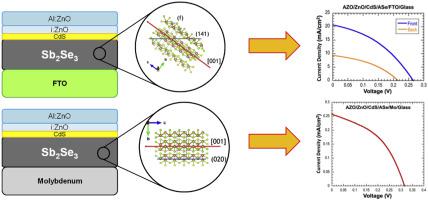当前位置:
X-MOL 学术
›
Sol. Energy Mater. Sol. Cells
›
论文详情
Our official English website, www.x-mol.net, welcomes your feedback! (Note: you will need to create a separate account there.)
Role of the substrates in the ribbon orientation of Sb2Se3 films grown by Low-Temperature Pulsed Electron Deposition
Solar Energy Materials and Solar Cells ( IF 6.9 ) Pub Date : 2020-12-01 , DOI: 10.1016/j.solmat.2020.110724 F. Pattini , S. Rampino , F. Mezzadri , D. Calestani , G. Spaggiari , M. Sidoli , D. Delmonte , A. Sala , E. Gilioli , M. Mazzer
Solar Energy Materials and Solar Cells ( IF 6.9 ) Pub Date : 2020-12-01 , DOI: 10.1016/j.solmat.2020.110724 F. Pattini , S. Rampino , F. Mezzadri , D. Calestani , G. Spaggiari , M. Sidoli , D. Delmonte , A. Sala , E. Gilioli , M. Mazzer

|
Abstract Antimony selenide (Sb2Se3) is a p-type semiconductor, considered as an excellent photovoltaic absorber for its high absorption coefficient in the visible region and a nearly optimal band-gap for single-junction solar cells. The simple binary composition, together with non-toxic and earth-abundant constituents make this material very promising toward industrial production of low-cost thin-film solar cells. Theoretical calculations and experimental data have confirmed that Sb2Se3 exhibits strong anisotropic optoelectronic properties, due to the presence of infinite covalent (Sb4Se6)n ribbons along the (001) direction, whereas weak van der Waals interactions occur between ribbons. In such anisotropic materials, electronic transport is strongly affected by crystal structure: when ribbons are aligned perpendicularly to the solar cell surface, a better collection of photogenerated current occurs, leading to larger photovoltaic conversion efficiencies. In order to understand the alignment mechanisms of ribbons, Sb2Se3 thin films were grown by Low-Temperature Pulsed Electron Deposition (LT-PED) technique at different temperatures (from 200 °C to 400 °C) on a variety of substrates, such as glass, molybdenum, CdS, Fluorine-doped Tin Oxide (FTO) and nanostructured ZnO. The structural and morphological characterization of the Sb2Se3 films, performed by out-of-plane and in-plane X-Ray Diffraction and micro-Raman spectroscopy, demonstrated that ribbon alignment along the surface normal is strongly dependent on the used substrate. The comparison between solar cells grown in substrate configuration on Mo and FTO, clearly demonstrates the influence of ribbon orientation on short-circuit current.
中文翻译:

衬底在通过低温脉冲电子沉积生长的 Sb2Se3 薄膜的带状取向中的作用
摘要 硒化锑 (Sb2Se3) 是一种 p 型半导体,因其在可见光区的高吸收系数和近乎最佳的单结太阳能电池带隙而被认为是一种优异的光伏吸收剂。简单的二元组成,加上无毒和地球上丰富的成分,使这种材料非常有希望用于低成本薄膜太阳能电池的工业生产。理论计算和实验数据证实,由于沿 (001) 方向存在无限共价 (Sb4Se6)n 带,而带之间发生弱范德华相互作用,因此 Sb2Se3 表现出很强的各向异性光电特性。在这种各向异性材料中,电子传输受到晶体结构的强烈影响:当带垂直于太阳能电池表面排列时,更好地收集光生电流,导致更高的光伏转换效率。为了了解带的排列机制,Sb2Se3 薄膜通过低温脉冲电子沉积 (LT-PED) 技术在不同温度(从 200 °C 到 400 °C)下在各种基板上生长,例如玻璃、钼、CdS、掺氟氧化锡 (FTO) 和纳米结构的 ZnO。通过面外和面内 X 射线衍射和微拉曼光谱进行的 Sb2Se3 薄膜的结构和形态表征表明,沿表面法线的带状排列强烈依赖于所使用的基材。在 Mo 和 FTO 上以基板配置生长的太阳能电池之间的比较清楚地证明了带状取向对短路电流的影响。
更新日期:2020-12-01
中文翻译:

衬底在通过低温脉冲电子沉积生长的 Sb2Se3 薄膜的带状取向中的作用
摘要 硒化锑 (Sb2Se3) 是一种 p 型半导体,因其在可见光区的高吸收系数和近乎最佳的单结太阳能电池带隙而被认为是一种优异的光伏吸收剂。简单的二元组成,加上无毒和地球上丰富的成分,使这种材料非常有希望用于低成本薄膜太阳能电池的工业生产。理论计算和实验数据证实,由于沿 (001) 方向存在无限共价 (Sb4Se6)n 带,而带之间发生弱范德华相互作用,因此 Sb2Se3 表现出很强的各向异性光电特性。在这种各向异性材料中,电子传输受到晶体结构的强烈影响:当带垂直于太阳能电池表面排列时,更好地收集光生电流,导致更高的光伏转换效率。为了了解带的排列机制,Sb2Se3 薄膜通过低温脉冲电子沉积 (LT-PED) 技术在不同温度(从 200 °C 到 400 °C)下在各种基板上生长,例如玻璃、钼、CdS、掺氟氧化锡 (FTO) 和纳米结构的 ZnO。通过面外和面内 X 射线衍射和微拉曼光谱进行的 Sb2Se3 薄膜的结构和形态表征表明,沿表面法线的带状排列强烈依赖于所使用的基材。在 Mo 和 FTO 上以基板配置生长的太阳能电池之间的比较清楚地证明了带状取向对短路电流的影响。



























 京公网安备 11010802027423号
京公网安备 11010802027423号